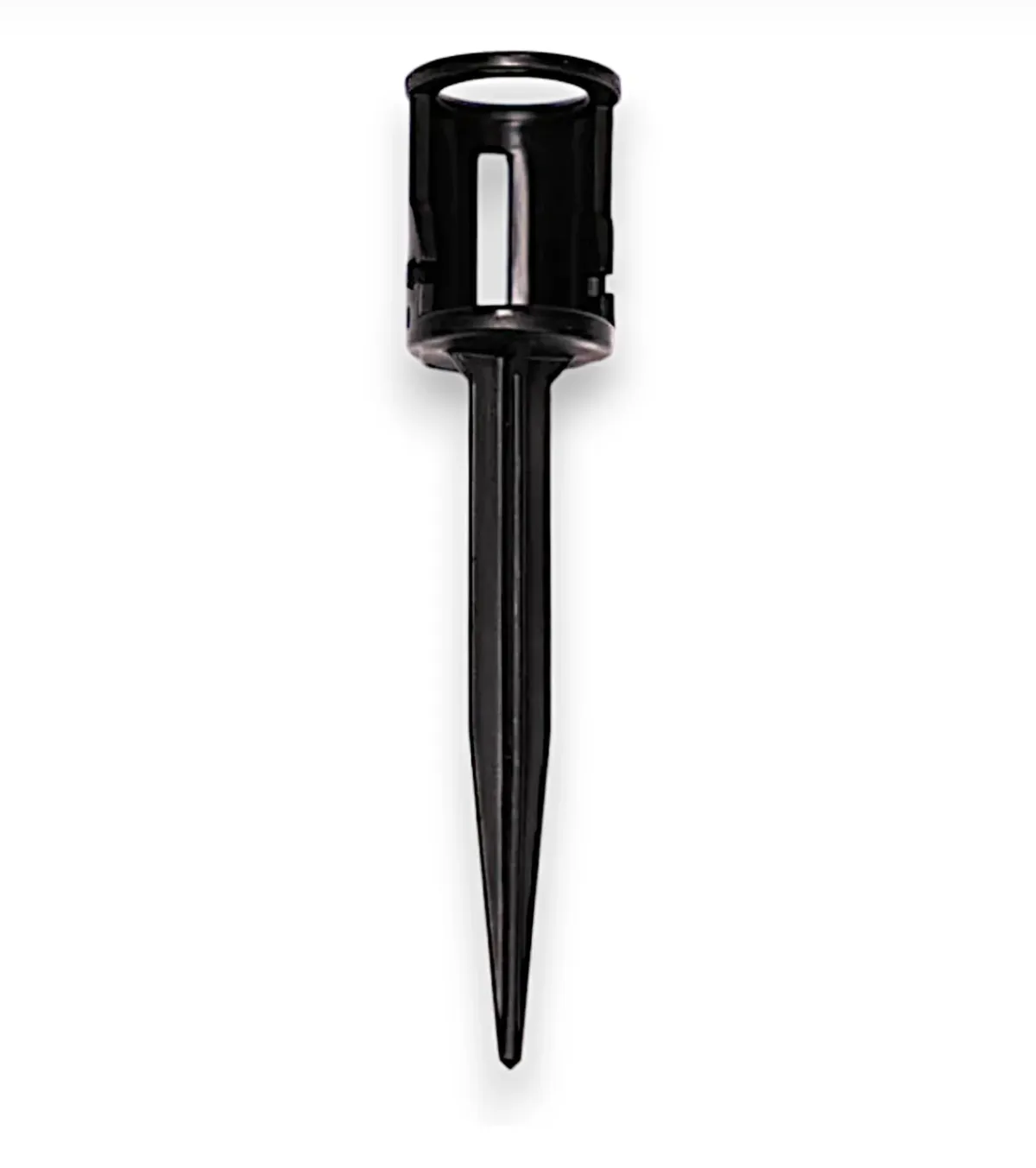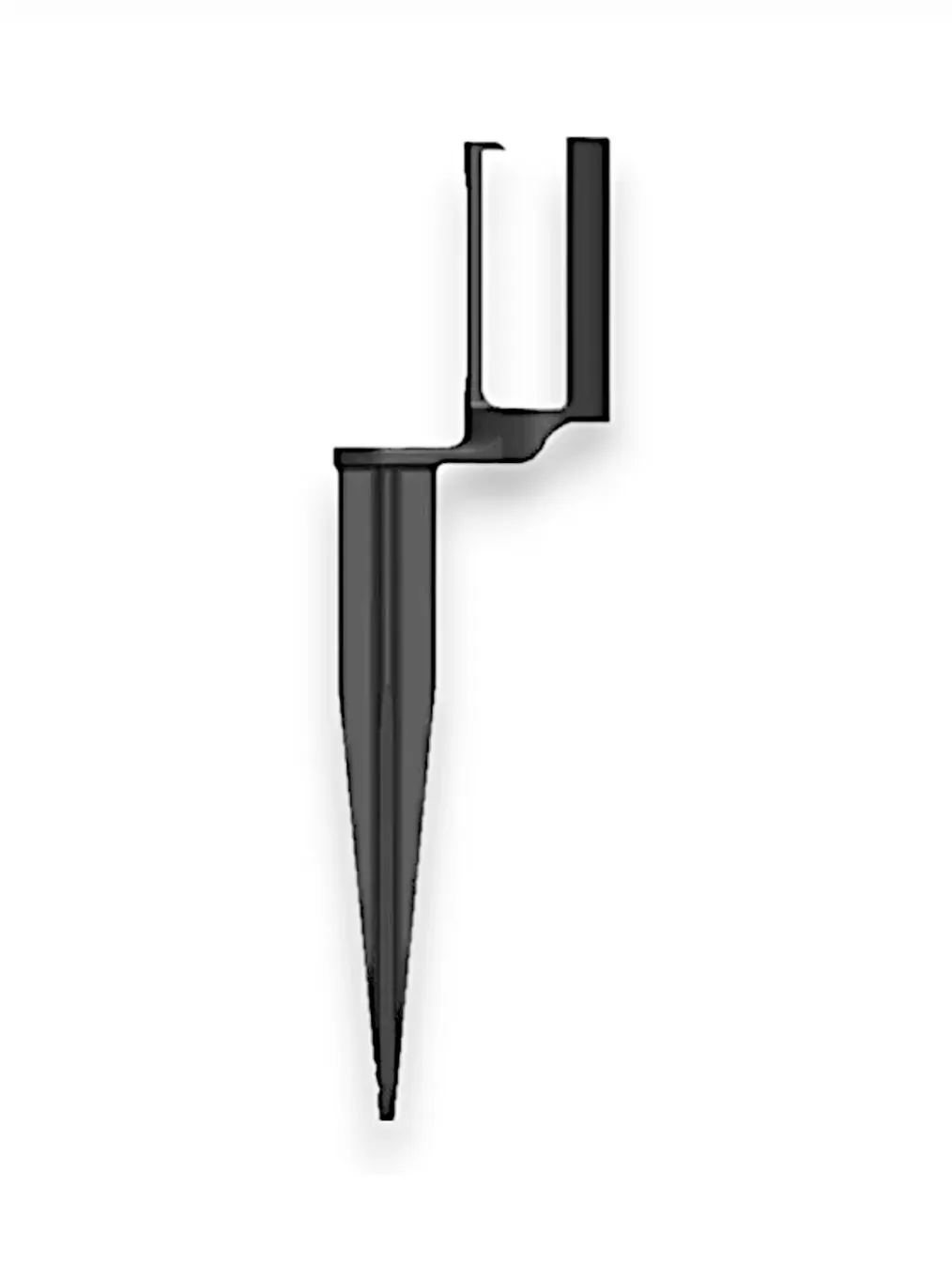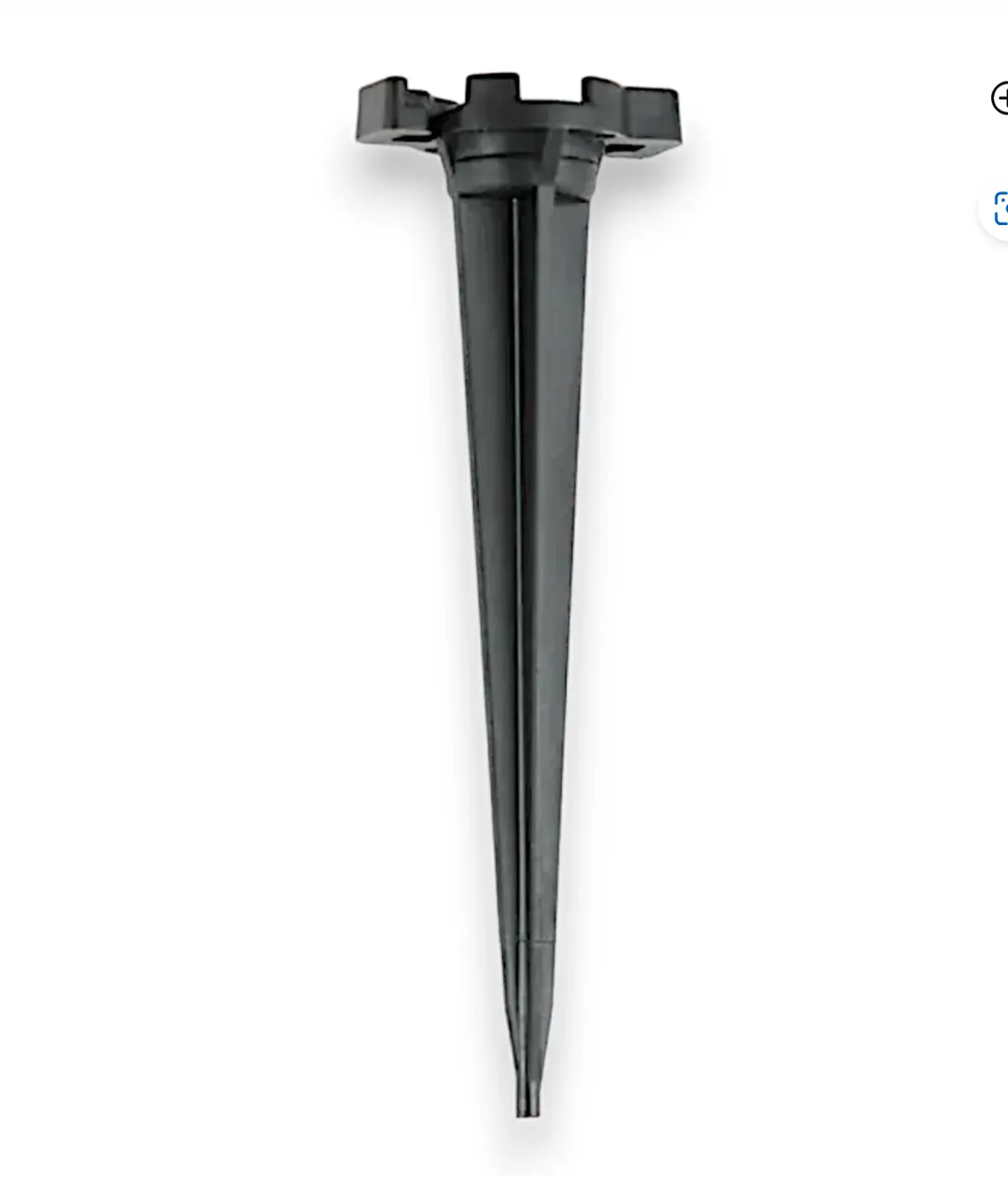Durable Light Stakes for Secure and
Professional Holiday Displays"
Ensure your holiday lights stay perfectly in place with our high-quality light stakes. Designed for durability and ease of use, these stakes provide a secure foundation for your outdoor Christmas displays, keeping your C7 and C9 lights neatly aligned and elevated. Whether you're a professional installer or a DIY enthusiast, our light stakes offer a reliable and long-lasting solution to enhance the beauty of your festive décor.
Light Stakes
C9/C7 Best Enclosed 5" Light Stake
Keep your outdoor Christmas lights securely in place with the C9/C7 Best Enclosed 5" Light Stake (Patent Pending). These stakes feature a unique enclosed design that firmly holds your C9 and C7 lights, ensuring they stay in place throughout the holiday season. Made from durable plastic, these stakes are designed to endure outdoor elements and can be reused year after year, making them a top choice for both professional and DIY decorators.
Key Features:
- Enclosed Design for Secure Hold: The enclosed design keeps your C9 and C7 bulbs securely fastened, preventing them from slipping out, even in challenging weather.
- Durable Plastic Construction: Crafted from high-quality plastic, these stakes are built to withstand harsh outdoor conditions, ensuring they last through multiple seasons.
- Reusable Year After Year: Designed for longevity, these stakes can be reused season after season, providing a cost-effective solution for your outdoor holiday displays.
- 5" Height: The 5" height is ideal for elevating your lights and keeping them neatly aligned along pathways, driveways, or garden beds for a clean, professional appearance.
- Patent Pending Design: With a patent-pending design, these stakes offer an innovative and effective solution for securing your C9 and C7 holiday lights.
Canny Systems Light Stake
The offset design of the Canny Systems Light Stake makes it easy to use a hammer on tougher ground. Available in 5", 7.5" and 11".
Features:
- 3-Prong Light Holders: Securely grip the light at the top of the socket for a more stable hold.
- Straight Alignment: Ensures your lights stay pointed straight up.
- Cord Protection: Prevents damage or strain on the socket cord.
- Quick Installation and Removal: Fast and easy install and removal
Universal 4.5" Light Stake
This 4.5" stake features a sharp point and rugged construction, making it easy to hammer into the ground if needed. It's perfect for neatly displaying lights throughout your landscape, creating a festive holiday atmosphere. Specifically designed to work best with standard C7 and C9 sockets.
Features:
- 4.5" Universal Light Stakes: Suitable for both C7 and C9 lights.
- Versatile Christmas Light Accessory: Ideal for outlining driveways, pathways, and yard edges along sidewalks with lights.
- Complete Your Display: These stakes help create a cohesive and polished look by extending your Christmas light display from the house down to the ground level.
Frequently Asked Questions
What types of lights do these stakes support?
Our light stakes are designed to securely hold C7 and C9 bulbs, providing a stable foundation for your holiday light displays.
Can these stakes be reused year after year?
Yes, our light stakes are made from durable plastic, allowing them to withstand harsh outdoor conditions and be reused season after season.
How easy is it to install and remove the light stakes?
Our light stakes feature an offset design that allows for quick and easy installation, even in hard ground. Removal is equally simple, making setup and takedown a breeze.
Will these stakes damage my light cords?
No, our stakes are designed to grip the light bulbs securely without putting any strain or causing damage to the socket cords.
Are there different sizes available?
Yes, our light stakes come in various sizes, including 5", 7.5", and 11", to accommodate different needs and ensure your lights are displayed at the perfect height.
Discover Expert Tips on Our Blog

Why Christmas Light Businesses Get Stuck at $50K (And How to Break Through)
Growing a Christmas lights installation business can be incredibly rewarding, but many entrepreneurs find themselves stuck at certain revenue levels—whether that's $30,000, $50,000, or even $300,000. The difference between staying stuck and breaking through to the next level often comes down to mindset, sales approach, and understanding what customers actually value.
The Mindset Problem That Keeps You Stuck
One of the most common barriers to growth is the belief that "people in my area just won't pay that much." This limiting mindset appears in markets of all sizes, from small towns to metropolitan areas with millions of residents. Consider this: in any major city, people purchase $100,000 cars, $10,000 handbags, and $10 daily coffee drinks. The money exists—the question is whether you believe your service is worth a premium price.
When creating content for your business, Google's systems prioritize helpful, reliable information created primarily to benefit people rather than manipulate search rankings. This principle applies equally to your pricing strategy and sales approach. If you don't genuinely believe your service provides exceptional value, your customers won't believe it either.
The reality is simple: if you can't sell your service at $6 per foot, you probably won't sell it at $8 per foot either—not because of the price, but because of how you're presenting it. The common denominator in failed sales isn't the price point; it's the person delivering the pitch.
What Are You Really Selling?
Here's a critical insight that separates struggling installers from thriving ones: you're not selling light bulbs. You're selling magic, memories, and peace of mind.
When analyzing successful Christmas lighting companies' Google reviews, a clear pattern emerges. Customers consistently mention:
Professional and courteous service
Friendly, respectful installers
Hassle-free experience
Attention to detail
Efficiency and speed
Taking the stress out of decorating
Creating neighborhood-admired displays
Notice what's absent from these reviews? Technical specifications about LED bulbs, peak-aligned lights, or wattage. While quality products matter, customers don't buy based on technical details—they buy based on the experience and results you deliver.
Understanding Customer Psychology Through Reviews
One effective strategy involves analyzing competitor reviews (or your own) using AI tools to identify common themes. When examining reviews from successful companies, phrases like these appear repeatedly:
"Professional and friendly"
"Above and beyond"
"Took all the hassle out"
"No mess, no stress"
"Stunning results"
"Neighbors keep complimenting"
Content should demonstrate first-hand expertise and depth of knowledge while clearly having a primary purpose that helps visitors achieve their goals. Your marketing materials should reflect these customer priorities rather than focusing on technical product specifications.
These insights reveal what truly matters to customers. Are your marketing materials, social media posts, and sales conversations emphasizing these elements? Or are you still talking primarily about bulbs and installation techniques?
Pricing Strategy and Sales Psychology
Many installers struggle with pricing confidence. They charge $6 per foot when they should charge $10 or $12, simply because they've heard competitors work at lower rates. But successful installers in the same markets are closing jobs at $10-$12 per foot—and even $20 per foot for premium clients.
The key difference isn't the market—it's the sales approach. When you present your service as a commodity (just hanging lights), customers will shop on price. When you present it as a transformative experience that creates cherished family memories without the hassle and danger of DIY installation, price becomes secondary.
Consider this sales framework: Instead of leading with "We'll hang C9 LED bulbs on your roofline," try "Imagine your grandchildren's faces lighting up when they see your home transformed into a winter wonderland. We handle everything—design, installation, maintenance, and takedown—so you can focus on creating memories instead of climbing ladders."
The Numbers Game and Consistency
Growing past revenue plateaus requires consistent, relentless marketing efforts. Successful installers don't "sometimes post on social media" or "occasionally put out yard signs." They systematically execute multiple marketing channels:
Daily social media posting across platforms
Continuous yard sign deployment
Active networking on LinkedIn (which has generated $15,000-$20,000 single jobs for some installers)
Professional Google Business profiles with regular updates
Email marketing campaigns
Strategic paid advertising
Google's systems analyze content relevance by looking at quantifiable signals and use aggregated interaction data to assess whether search results match user intent. Similarly, your marketing success depends on creating consistent signals across multiple channels that demonstrate your authority and reliability.

Expect closing rates of 15-25% when charging premium prices. This means 8-9 "no" responses for every 1-2 "yes" responses. The solution isn't lowering prices—it's increasing the number of quality leads entering your sales funnel.
The In-Person Sales Process
For installers conducting in-person estimates, the process should focus on building relationships rather than discussing technical specifications. Here's an effective framework:
Pre-Visit Preparation
Send a video or email with your photo before arriving. This reduces anxiety (particularly important since many decision-makers are women concerned about security) and begins building familiarity. Ensure all decision-makers will be present to avoid the dreaded "I need to talk to my spouse" objection.
The Walk-Around
As you approach the property, identify conversation starters—landscaping, vehicles, sports team flags, or other personal touches. Use these to build rapport before discussing the project. This isn't manipulation; it's genuine relationship building.
During the walk-around, ask questions about their motivations:
Why are they having lights installed?
Are grandchildren visiting?
What memories are they hoping to create?
What colors or styles appeal to them?
Take notes on family members' names and personal details. You'll use these later in your closing conversation.
The Kitchen Table Close
Request to sit at the kitchen table to review the proposal. This matters because friends sit at kitchen tables—it's an intimate, trust-building location. Present three package options, but only reveal the top tier initially.
Use the personal information gathered earlier: "This premium package will make little Johnny's face light up when he arrives for Christmas. Imagine him looking out the window at this magical display. We can have this installed by Tuesday for $4,954."
Then stop talking. The first person to speak after stating the price typically loses the negotiation.
If they express price concerns, move to your middle package. If needed, present the basic package. But always lead with premium options—you can't upsell a package you never presented.

Marketing Messages That Convert
When creating content, consider whether you have an existing audience that would find it useful, whether it demonstrates first-hand expertise, and whether readers will feel they've learned enough to achieve their goal.
Based on customer review analysis, your marketing should emphasize:
Professional, friendly service: "Our courteous, uniformed installers treat your property with respect"
Hassle-free experience: "From design to takedown, we handle everything"
Stunning results: "Create the home your neighbors will admire all season"
Safety and convenience: "No ladders, no stress, no emergency room visits"
Memory creation: "Focus on family time, not ladder time"
Social media posts might include phrases like:
"Christmas lights made magical without the stress"
"Want your house to be the one neighbors compliment this season?"
"Hallmark movie vibes without the ladders and struggles"
Overcoming Common Obstacles
"I'm booked until November"
If you're fully booked before the season starts, you're underpriced. Raise your rates immediately. Additionally, consider hiring and training installers to expand capacity. Being booked solid at low prices means you're leaving significant revenue on the table.
"I'm not tech-savvy"
This can actually be an advantage. Installers who get too technical tend to oversell product features rather than benefits and emotions. You can easily outsource technical tasks (website management, social media scheduling, photo editing) while focusing on what you do best—building relationships and closing sales.
Focus on developing your sales and customer service skills. Technical installation knowledge can be taught to employees; sales ability is your irreplaceable asset.
"I don't have many reviews yet"
Google primarily finds pages through links from other pages, and other sites linking to you happens naturally over time, though you can encourage people to discover your content through promotion. Similarly, reviews accumulate over time through excellent service and strategic requests.
In your first year, focus on delivering exceptional experiences to every customer. Use referral programs, follow-up communications, and gentle review requests to build your reputation. Consider offering small incentives (gift cards to popular restaurants) for referrals.
Platform-Specific Strategies
LinkedIn for Commercial Opportunities
Don't overlook LinkedIn for B2B opportunities. Installers have recently secured $15,000-$20,000 commercial contracts through consistent LinkedIn engagement. Share professional content, engage with local business posts, and position yourself as the go-to expert for commercial holiday lighting.
Google Business Profile Optimization
Search systems aim to prioritize content that demonstrates expertise, authoritativeness, and trustworthiness, with trust being the most important aspect. Your Google Business Profile is crucial for local visibility. Optimize it with:
Professional photos of completed installations
Regular posts highlighting current projects
Prompt responses to reviews (both positive and negative)
Accurate business information and service areas
Posts emphasizing customer benefits (not product features)
Social Media Content Calendar
Create a content calendar that includes:
Before/after installation photos
Customer testimonial videos
Team member spotlights (building trust through familiarity)
Educational content about safety and convenience
Behind-the-scenes installation processes
Seasonal tips and decoration ideas

First-Year Expectations
If this is your inaugural season, manage expectations realistically. Most new installers don't see significant sales until November. This isn't failure—it's normal business development.
Don't compare your first-year results to established companies with years of reputation, hundreds of reviews, and refined marketing systems. Instead, focus on:
Delivering exceptional service to every customer
Building your review base
Refining your sales process
Establishing relationships in your community
Learning what marketing channels work best in your market
Taking Action
Success in the Christmas lights installation business requires more than technical skill—it demands belief in your value, understanding of customer psychology, consistent marketing execution, and a sales process focused on benefits rather than features.
The difference between staying stuck at your current revenue level and breaking through to the next tier isn't about working harder at installation. It's about working smarter at sales, marketing, and mindset development.
Start by analyzing what successful competitors' customers say they value. Adjust your marketing messages to emphasize these benefits. Raise your prices to reflect the true value you provide. Execute consistent marketing across multiple channels. And most importantly, believe that you're worth premium pricing—because if you don't believe it, your customers never will.

How do I know if I'm charging enough for my services?
If you're booked solid weeks before the installation season begins, you're likely underpriced. Premium pricing (typically $8-$12+ per foot for residential) should result in a closing rate of 15-25%. If you're closing significantly more than 25% of quotes, you have room to increase prices. Remember, customers willing to pay $600 for a service will often pay $800 for better service presentation.
What should I focus on in my marketing instead of product features?
Focus on benefits and emotional outcomes: professional service, hassle-free experience, safety, family memory creation, and stunning results that impress neighbors. Analyze competitor reviews to identify the language customers actually use when describing value, then incorporate those themes into your marketing.
How can I compete with installers charging much less than me?
You're not competing on price—you're competing on value and experience. Lower-priced competitors attract price-sensitive customers; premium pricing attracts quality-focused customers who value professionalism, reliability, and peace of mind. These are different market segments. Focus your marketing on attracting your ideal customer rather than competing for everyone.
What's the most effective way to close in-person sales?
Build genuine relationships first by finding common ground and asking about their motivations and family. Present three package options but lead with the premium tier, using personal details gathered during conversation. For example: "This package will create the magical experience you mentioned wanting for when your grandchildren visit." After stating the price, remain silent until they respond.
How long does it take to start seeing consistent sales in a new market?
First-year installers typically don't see significant sales momentum until November. This is normal. Years 2-3 show substantial growth as you build reviews, refine processes, and develop market reputation. Focus first-year efforts on delivering exceptional service to build your foundation rather than expecting immediate high revenue.

Should I offer discounts to close more sales?
Discounting typically indicates a sales process problem, not a pricing problem. If customers aren't buying at your regular price, they usually won't buy at a discounted price either—you're just making less profit. Instead, improve your value presentation, better qualify leads, and ensure you're targeting customers who value quality over lowest price.
How many marketing channels should I actively use?
Successful installers typically execute 5-7 marketing channels consistently: social media (multiple platforms), Google Business Profile, yard signs, email marketing, networking (including LinkedIn for commercial work), referral programs, and either paid advertising or content marketing. Consistency matters more than channel quantity—better to excel at three channels than poorly execute ten.
What if customers say they need to "think about it" or "talk to their spouse"?
Prevent this objection by ensuring all decision-makers attend the initial consultation. If it still occurs, schedule a specific follow-up time rather than leaving it open-ended: "I understand you'd like to discuss this together. How about I follow up with you tomorrow at 3 PM? Does that work?" This maintains momentum and demonstrates professionalism.
How do I justify premium pricing to skeptical customers?
Don't justify—demonstrate value. Emphasize safety (no ladder accidents), convenience (you handle everything), expertise (professional design and installation), reliability (insured, established business), and results (testimonials, portfolio). Price objections often signal that you haven't adequately communicated value, not that your price is too high.
What's the best way to get more customer reviews?
Make review requests part of your standard process: send a follow-up email 2-3 days after installation with direct links to your review platforms. Consider implementing a referral reward program offering incentives like restaurant gift cards for both reviews and referrals. The key is having a systematic approach rather than randomly requesting reviews.
Copyright ©2025 All Right Reserved website designed by christmaslights.io
Terms of Service / Privacy Policy
Have questions or need assistance?
Contact us at (855)619-LITE





